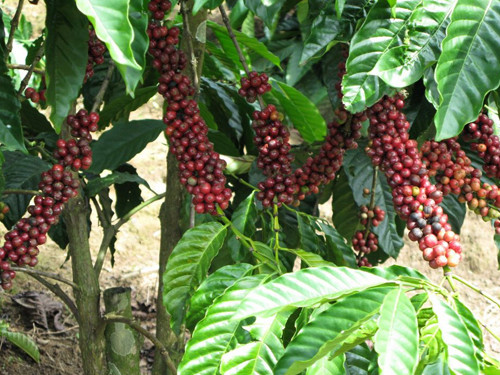Coffee prices increased at the beginning of the year
Coffee prices in all markets have increased sharply. A capital adjustment of investment funds is taking place on the futures exchanges. Coffee prices, which were suppressed in 2013, are now being compensated urgently. On the other hand, there are rumors that the next crop will not be as big as many people think.
 |
But this misfortune only happened for one day. The Liffe NYSE robusta futures floor price gradually recovered strongly.
In the domestic market in the Central Highlands provinces, on the opening day, the price was only 33,000 VND/kg, down 500 VND/kg compared to the last day of the previous year. However, by this morning, Saturday, January 11, many places were offering quite a bustling sale at around 35,000 VND/kg, up 2,000 VND/kg. "Unlike the miserable months at the end of the old year with the VAT refund plan, 'check first, refund later' which made businesses not bold enough to trade, now buying and selling is being 'reopened'," a representative of a foreign-invested company in Lam Dong happily reported.
Meanwhile, many farmers have also started selling coffee, although the sales volume is not as massive as many people think. “The goods are now available, whenever I need money, I sell a little at many prices, 33,000 VND is available, 34,500 VND is also available…”, a farmer named Thanh with a garden in Dinh Trang Hoa, Di Linh, Lam Dong said.
With only about three weeks left until Lunar New Year, “the gradual increase in prices is good news, I have more conditions to buy some more flowers and incense for the holidays…”, Mr. Thanh was happy to see the prices increase again.
Indeed, after a sudden drop of $69/ton on January 2, the London robusta floor price has gradually increased. By the end of the week yesterday, Friday, January 10, the London robusta futures price closed at $1,739/ton, up $125 compared to the opening day of the "unlucky" year.
Structurally, the robusta floor price is inverted because the March 2014 price is 30 USD/ton higher than the May price. This indicates that the market is in need of immediate delivery and is willing to pay a higher price. If sold for long-distance delivery, the shipper must accept a discount of 30 USD/ton. This is a strict condition because the cost of long-distance delivery is usually higher than that of short-distance delivery.
Arabica futures prices also increased sharply during these days. At the end of the week, the New York floor reached 122.90 cts/lb, up 9.2 cts compared to January 2, equivalent to 203 USD/ton.
Why the price increase?
The sudden and strong price increase in the past few days is explained by the fact that after each quarter and each year, investment funds often adjust their capital and investment portfolio, adjusting the increase by pulling capital back to place new bets on places where prices were suppressed in the previous period. This adjustment will last for several consecutive days.
At the Liffe NYSE futures exchange, the exchange’s robusta-certified inventories continued to decline, according to its biweekly report. As of January 6, the Liffe NYSE certified inventories fell by another 1,820 tonnes compared to the previous report, to 28,200 tonnes, down 73.11% from 52 weeks ago, when they stood at 104,860 tonnes.
Meanwhile, the inventory of arabica Ice New York standards as of January 10 was at 161,560 tons, 5.7 times higher than the inventory of robusta floor. It is estimated that about 105,000 tons of arabica standards are present in warehouses in Europe, waiting there to wait for conditions to replace robusta in this large consumer market.
Public opinion of the rotating output
Just in the first few days of 2014, market opinion on the world's coffee supply and demand has changed, and as a result, coffee prices on the two futures exchanges are also benefiting.
Conab, the agency responsible for assessing crop yields under the Brazilian Ministry of Agriculture, said that due to the recent low price of Arabica coffee in the last 6 years, Brazilian farmers have lost confidence in the effectiveness of coffee trees and quickly switched to growing other crops. Therefore, according to Conab, the next crop year, which should have been the "good year" of the cycle, is now the "lost year", with Brazil's coffee output estimated to only reach 46.53 to 50.15 million bags (60 kg x bag). This figure is not much higher than 2013 in the "lost year" cycle, when the agency estimated about 49.15 million bags, while many other estimates put the figure at 57-60 million bags.
According to the biological cycle of Arabica coffee plants in this country, if this year's crop fails, next year's crop will be available.
Also on this occasion, the Swiss-based coffee trading company Volcafe also said that Brazil's next crop output will be only 51 million bags due to "poor fruit set...because the coffee trees have produced two consecutive good crops." However, Volcafe's Brazil output figure for the recently harvested crop is 57.2 million bags, 8 million bags higher than Conab's estimate.
For a long time, when commodity exchanges were just bait for hedge funds, production announcements were often considered just “rumors”: when someone wanted prices to increase, they said production would decrease, and when demand for prices decreased, they often said there would be a good harvest.
To avoid damage caused by rumors, consuming countries and large businesses in the world often have departments to research their production, have serious statistics and act according to the numbers their units learn.
That is also a valuable experience for the domestic coffee industry.
According to Saigon Economics






